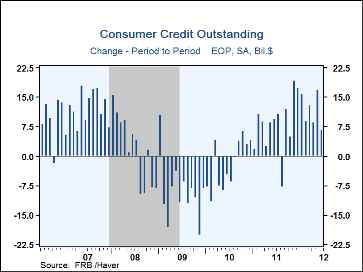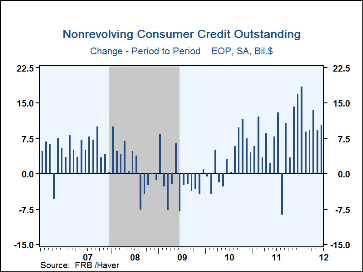 Global| Aug 07 2012
Global| Aug 07 2012U.S. Consumer Credit Growth Eases
by:Tom Moeller
|in:Economy in Brief
Summary
Consumer credit usage cooled down in June after a blistering start this spring. The Federal Reserve reported that credit grew $6.5B (AR) after a $16.7B rise in May, revised from $17.1B. A $10.5B increase had been expected by Action [...]
 Consumer credit usage cooled down in June after a blistering start this
spring. The Federal Reserve reported that credit grew $6.5B (AR) after a
$16.7B rise in May, revised from $17.1B. A $10.5B
increase had been expected by Action Economics. The gain left the y/y
rise at 5.1%, nearly its quickest since June 2008.
Consumer credit usage cooled down in June after a blistering start this
spring. The Federal Reserve reported that credit grew $6.5B (AR) after a
$16.7B rise in May, revised from $17.1B. A $10.5B
increase had been expected by Action Economics. The gain left the y/y
rise at 5.1%, nearly its quickest since June 2008.
Usage of revolving credit eased the most. The $3.7B decline (+0.7% y/y) compared to a $7.5B May spurt. Savings institutions lending rose 5.7% y/y and credit union lending gained 4.5% y/y. Pools of securitized assets rose 2.8% y/y. and commercial bank lending increased 0.9% y/y. Finance company credit fell 5.4% y/y.
Non-revolving credit loans, which account for roughly two-thirds of total borrowing, rose at a $10.2B rate (7.4% y/y). Loans from the federal government grew 29.9% y/y and pools of securitized assets gained 7.1% y/y. Credit union borrowing rose 3.1% y/y while commercial bank lending increased 1.6% y/y. Savings institutions borrowing fell 17.7% y/y.
During the last ten years, there has been a 52% correlation between the y/y change in credit outstanding and the change in personal consumption expenditures, although the correlation recently has weakened considerably. The credit figures are the major input to the Fed's quarterly Flow of Funds accounts for the household sector.
The consumer credit data are available in Haver's USECON database. The Action Economics figures are in the AS1REPNA database.
Financial Education is the title of today's speech by Federal Reserve Chairman Ben S. Bernanke and it is available here.
| Consumer
Credit Outstanding (M/M Chg, SAAR) |
Jun | May | Apr | Y/Y | 2011 | 2010 | 2009 |
|---|---|---|---|---|---|---|---|
| Total | $6.5B | $16.7B | $8.5B | 5.1% | 4.0% | -1.1% | -4.3% |
| Revolving | -3.7 | 7.5 | -4.9 | 0.7 | 0.9 | -7.0 | -8.7 |
| Non-revolving | 10.2 | 9.2 | 13.4 | 7.4 | 5.7 | 2.5 | -1.4 |
Tom Moeller
AuthorMore in Author Profile »Prior to joining Haver Analytics in 2000, Mr. Moeller worked as the Economist at Chancellor Capital Management from 1985 to 1999. There, he developed comprehensive economic forecasts and interpreted economic data for equity and fixed income portfolio managers. Also at Chancellor, Mr. Moeller worked as an equity analyst and was responsible for researching and rating companies in the economically sensitive automobile and housing industries for investment in Chancellor’s equity portfolio. Prior to joining Chancellor, Mr. Moeller was an Economist at Citibank from 1979 to 1984. He also analyzed pricing behavior in the metals industry for the Council on Wage and Price Stability in Washington, D.C. In 1999, Mr. Moeller received the award for most accurate forecast from the Forecasters' Club of New York. From 1990 to 1992 he was President of the New York Association for Business Economists. Mr. Moeller earned an M.B.A. in Finance from Fordham University, where he graduated in 1987. He holds a Bachelor of Arts in Economics from George Washington University.








